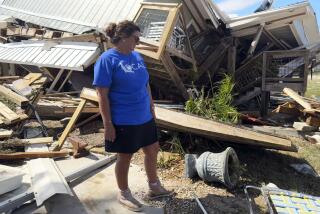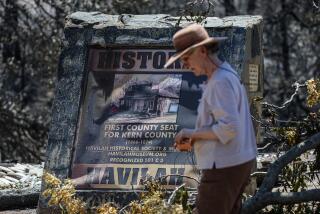A Town’s Life Among the Ruins
- Share via
INDIANOLA, Texas — A smattering of slumping gravestones and a cistern made of concrete are all that remain of what was once this state’s second-largest seaport.
Indianola was a prosperous boomtown with a prized deep-water port on the western shore of Matagorda Bay. It was a rival to wealthy Galveston, Texas, and its future seemed far brighter than that of a swampy backwater called Houston. The port was the arrival point for thousands of German immigrants who helped push the town’s population to 5,000.
But a potent hurricane in 1875 pounded Indianola into pieces and killed more than 200 people. Then another powerful hurricane hit in 1886 and crushed what little civic spirit was left. Settlers -- those still alive -- abandoned the “Dream City on the Gulf.”
Indianola, now considered the queen of Texas ghost towns, stands as a solemn reminder that the end of civilization on the Gulf of Mexico could be a hurricane away. Even the title of ghost town seems generous for the pitiful remains of the original site: Due to coastal erosion and the pummeling of successive storms, the old town grid, roughly 15 blocks by four blocks, sits almost entirely underwater.
Indianola also serves as a reminder that wherever ocean breezes beckon, people will return. Last century, the shoreline next to the site of the old town was slowly built up again with shacks and fishing huts, only to be pulverized by Hurricane Carla in 1961. Now the same adjacent area is filling up once more with vacation homes on stilts that sell for more than $125,000.
Although it is not quite a town, about 300 people live in the new version of Indianola, and roughly three times as many spend summer weekends there. They reside along a receding beach, protected by an unsightly barricade of concrete blocks dumped into the bay in the last decade as a desperate measure to slow the hurricane-powered erosion.
“Everybody is fully aware that another one will hit -- it’s just a matter of time,” said Mike Richter, 46, who has lived in Indianola nearly all his life and now rents a trailer by the water.
“We’re taking a gamble because we love the water. It’s just like the people in California. They know the big earthquake is going to come someday. But they don’t leave, do they?”
Richter said he is a descendant of the French explorers who first sailed down to the mouth of the Mississippi River in 1682. They were led by Robert Cavelier de La Salle, who two years later tried to retrace his journey but wound up far off course and blown ashore in 1685 near what would become Indianola. The expedition was considered a fiasco, and La Salle died in inglorious fashion in 1687: killed in a mutiny by his own men.
Still, a 22-foot granite statute in Indianola commemorates La Salle’s landing. Carla’s gales pushed his statue half an inch off its base, leading to a local legend that the old explorer is turning his back on the sea. An earlier statue of La Salle succumbed to hurricane winds. Only its boots still stand.
“If you live near the water here, that’s the chance you take,” said Kim Spree, 37, who works the cash register at the Indianola Fishing Marina. Another bait shop, Ed Bell’s, stood on almost the same spot before Carla blew it apart. In homage, a black-and-white picture of Ed Bell’s now graces the marina’s wall, next to a weather photo of the most recent hurricane to clobber Indianola: Claudette in 2003.
Like the people of La Conchita, the California village periodically crushed by mudslides, residents of Indianola say they stay despite the danger because they are enamored of the place.
The charms of Indianola are significantly less discernible to outsiders. Chemical refineries across the bay mar the shoreline views, and ghastly swarms of Gulf mosquitoes descend on unsuspecting visitors like something out of the biblical plagues of Egypt.
“It’s not the most scenic spot in the world, but I grew up around here,” said Jim Meyer, 59, who was busy building a nook to dock his boat beneath his vacation house. As Meyer spoke, his wife, Harriet, slathered herself with oily insect repellent to ward off the mosquitoes, which were even more aggressive than usual after a round of rains. When she was finished, she picked up their small golden-haired dog, Jackson, and lathered him up with repellent as well.
Indianola’s destruction should have served as a clear warning to Galveston, but it did not.
A hurricane lashed an unprepared Galveston in 1900, killing 6,000 people. It still stands as one of the deadliest disasters in American history. Survivors rebuilt, but the city never regained its prominence. Galveston was surpassed by Houston, now the nation’s fourth-largest metropolis and one of its top 10 ports.
“The people in Galveston had before them the example of Indianola, and yet they still thought they were impervious,” said Kerry A. Emanuel, a professor at the MIT, author of “Divine Wind: The History and Science of Hurricanes.”
“I suppose it is a psychological necessity for people to think it cannot happen to them.”
Up the road from Indianola in Port Lavaca, an exhibit at the Calhoun County Museum brings old Indianola back to life and explains its death. A painstakingly produced model reconstructs the town’s long wooden piers, which carried trains directly to the ships to load them with silver from Mexico and beef from the Texas hinterlands. It also shows many of Indianola’s former buildings, including its large courthouse. Their foundations now lie 30 feet in water.
There are heirlooms that survived the big storms too, including a grand piano with elegant cabriole legs that Indianola resident Samuel Kinlay had purchased from Boston in 1872 for his daughter Frieda, a piano teacher. The family carefully wrapped the piano in quilts and mattresses before fleeing. When they returned home, the only things left were the living room floor and the piano.
George Anne Cormier, the museum’s director, knows the sad stories as well as anyone. Still, she chooses to live down by the ruins in Indianola.
“It’s beautiful. I can look out my window and see the bay, the birds, the dolphins,” Cormier said, smiling.
“In life, you have to put up with some things to get what you want.”
More to Read
Sign up for Essential California
The most important California stories and recommendations in your inbox every morning.
You may occasionally receive promotional content from the Los Angeles Times.










